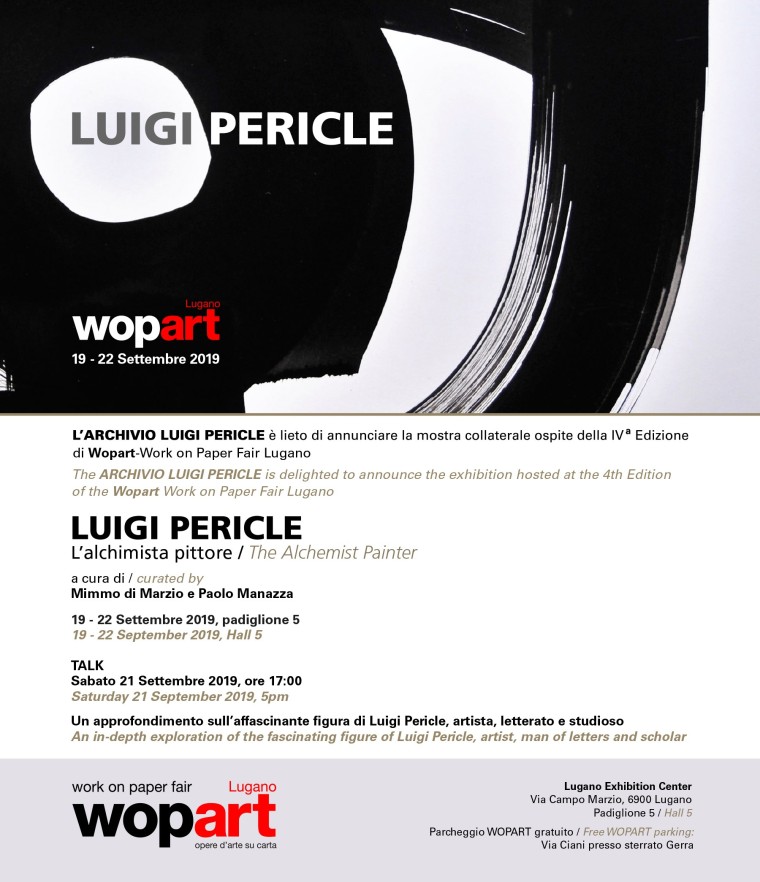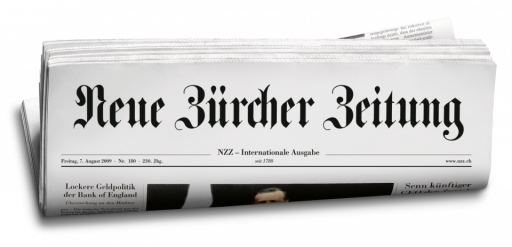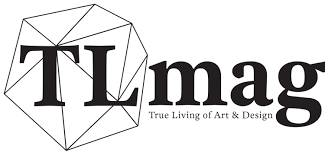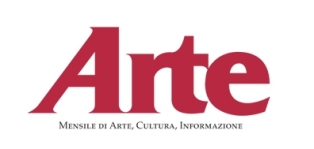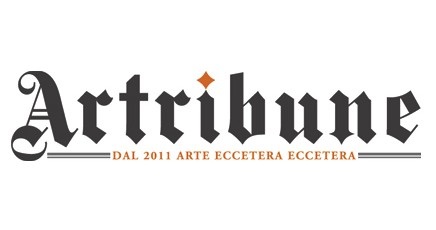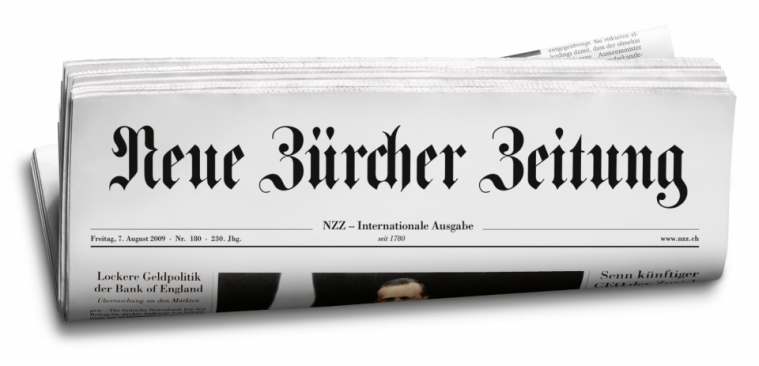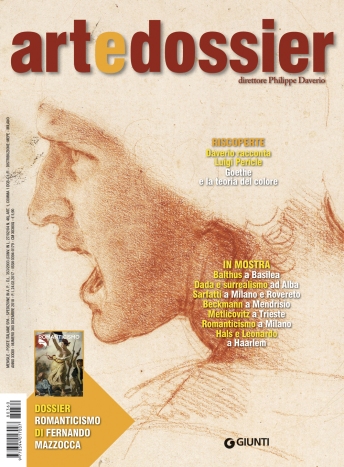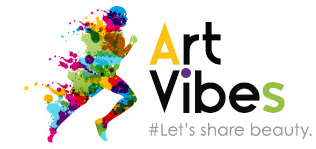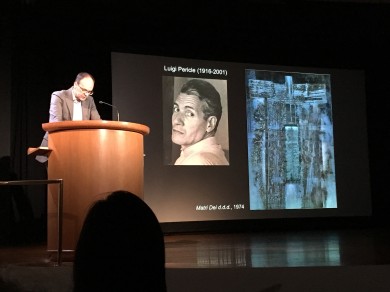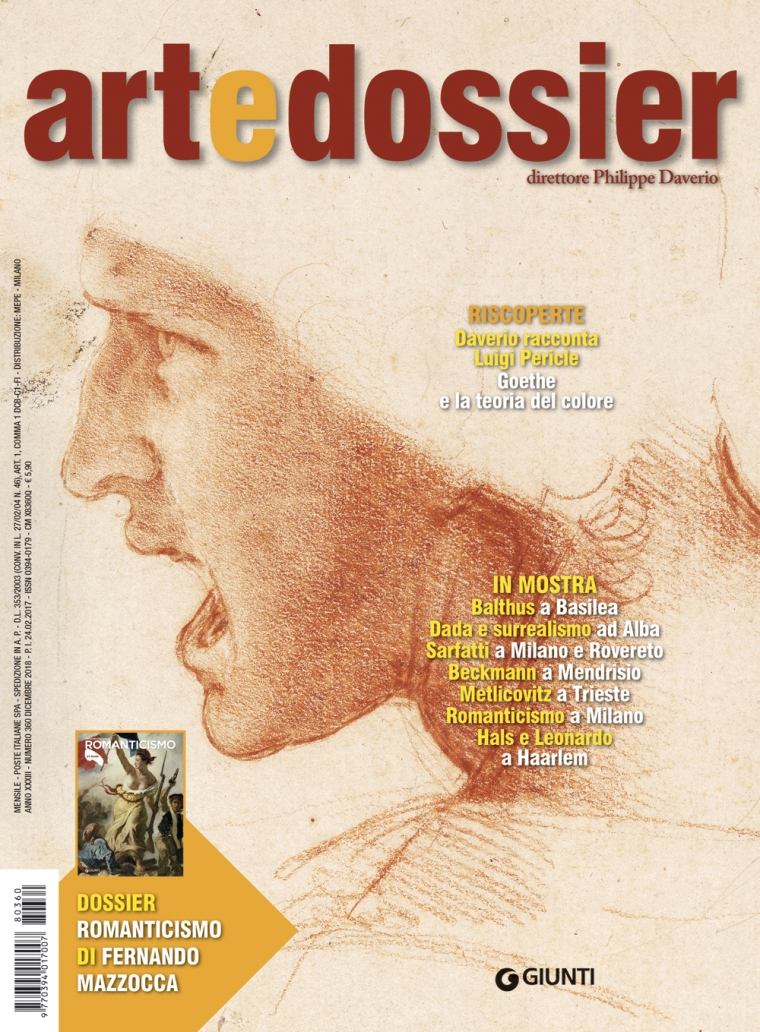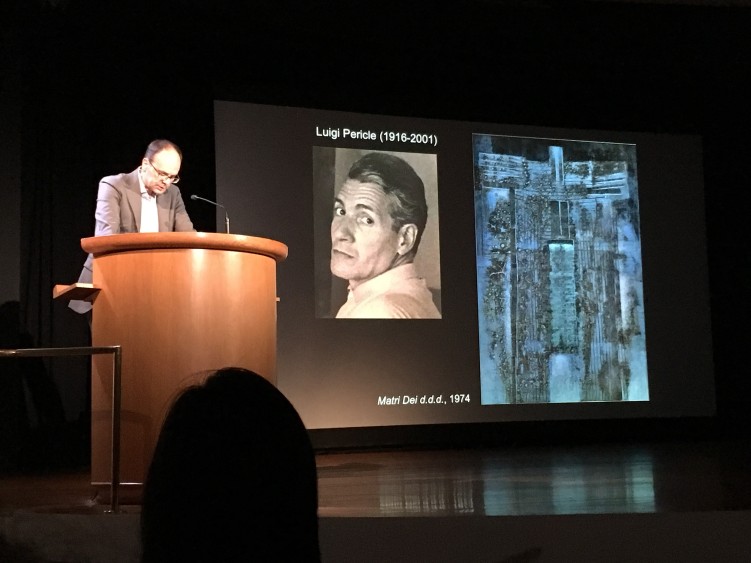MEDIA RESUME
Press Release ITA/FRA/GER/ENGL.
PER_30_30_01 Pericle_Venezia_IT
PER_30_30_01 Pericle_Venezia_FR
PER_30_30_01 Pericle_Venezia_EN
PER_30_30_01 Pericle_Venezia_DE
CLICK ON THE ICONS
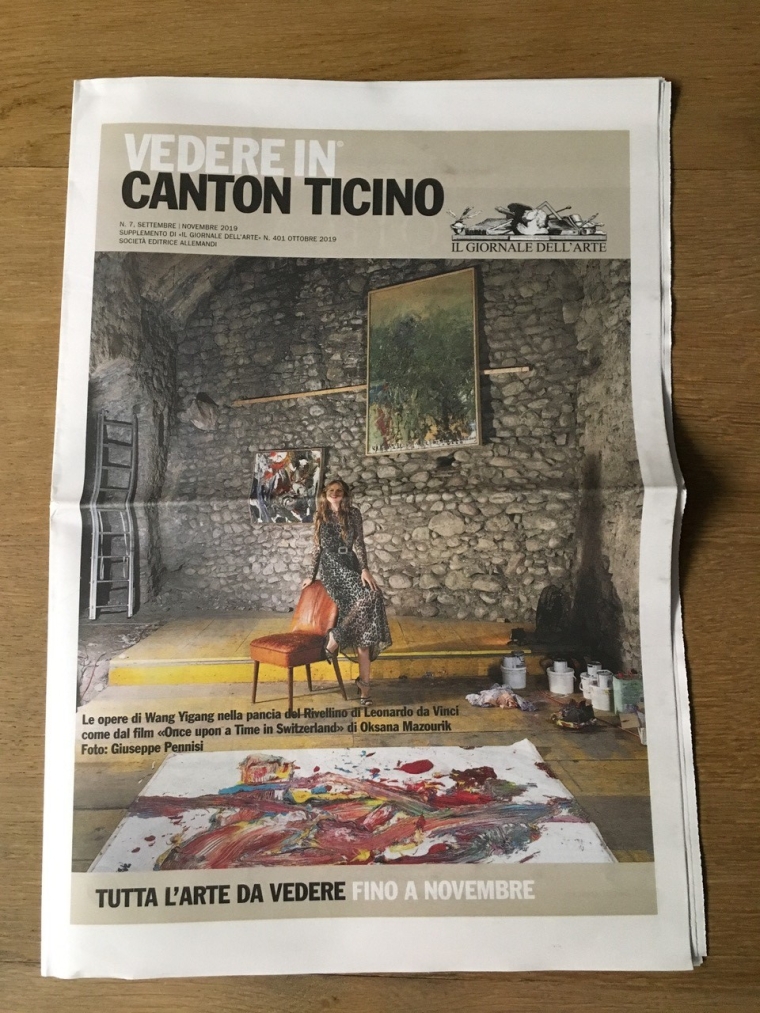
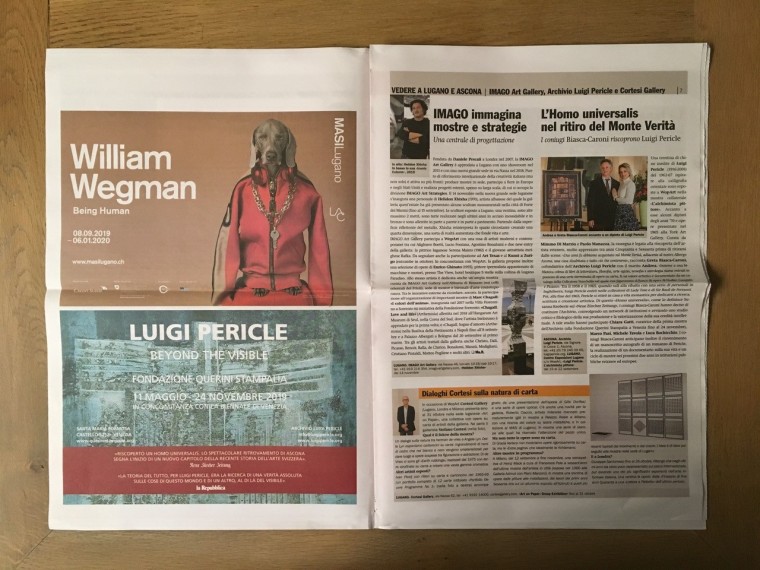
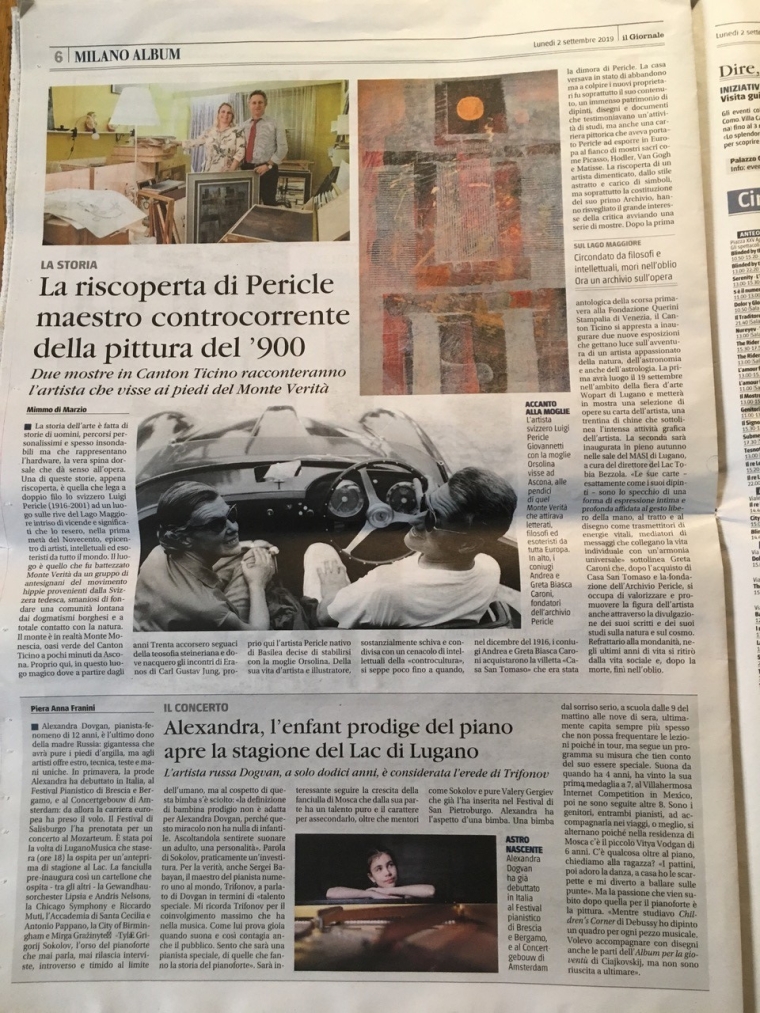
LUIGI PERICLE_Querini Stampalia_Segno274
Marco Pasi at the Guggenheim NY, read the report
Marco Pasi on the “Corriere del Ticino”
An unpublished Luigi Pericle discovered in Ascona.
With the purchase of Luigi Pericle Giovannetti’s former house (1916-2001), the owners of the Hotel Ascona have brought to light an unprecedented artistic treasure. The versatile artist reached the peak of his career at the end of the 1950s thanks to the Staechelin family, who bought a hundred of his paintings. To let him work undisturbed, collectors gave him a house on the slopes of Monte Verità in Ascona, where Luigi Pericle spent most of his life. The collection found consists of oil paintings and ink drawings in excellent condition, some of which can also be admired at the Hotel Ascona.
Un Luigi Pericle inedito scoperto ad Ascona.
Con l’acquisto dell’ex casa di Luigi Pericle Giovannetti (1916-2001), i proprietari dell’Hotel Ascona hanno portato alla luce un tesoro artistico inedito. Il poliedrico artista raggiunse il culmine della sua carriera alla fine degli anni ’50 grazie alla famiglia Staechelin che acquistò un centinaio di suoi dipinti. Per lasciarlo lavorare indisturbato, i collezionisti gli regalarono una casa sulle pendici del Monte Verità ad Ascona, dove Luigi Pericle trascorse gran parte della sua vita. La collezione trovata è composta da dipinti ad olio e disegni a inchiostro in ottimo stato di conservazione, alcuni dei quali si possono ammirare anche all’Hotel Ascona.
QUOTIDIANO TRAVEL :
Svizzera protagonista di progetti che valorizzano il patrimonio artistico
A land of private or corporate collectors and patrons, Switzerland has always been the protagonist of projects that aim to enhance the existing artistic heritage or to create new spaces and new ways to bring people closer to creativity. Waiting for the opening of the new wing of the Kunsthaus in Zurich, entrusted to David Chipperfield, and Plateforme10 in Lausanne, here are some new features. Le Corbusier designed this building on the eastern shore of Lake Zurich on behalf of the collector Heidi Weber, who made it an exhibition space for her artistic works, from oil paintings to drawings, furniture and sculptures. Atypical is the use of glass, steel and panels of colored paint instead of the usual stone and concrete. It was inaugurated in 1967 and is still dedicated to all the architect’s works. It will reopen on 11 May 2019 under the auspices of the Zurich Design Museum. With the purchase of the former home of Luigi Pericle Giovannetti (1916-2001), the owners of the Hotel Ascona have brought to light a new artistic treasure. The versatile artist reached the peak of his career at the end of the 1950s thanks to the Staechelin family, who bought a hundred of his paintings. To let him work undisturbed, collectors gave him a house on the slopes of Monte Verità in Ascona, where Luigi Pericle spent most of his life. The collection found is composed of oil paintings and ink drawings in excellent condition, some of which can also be admired at the Hotel Ascona.
Terra di collezionisti e di mecenati privati o aziendali, la Svizzera è da sempre protagonista di progetti che mirano a valorizzare il patrimonio artistico esistente o a creare nuovi spazi e nuovi modi per avvicinare le persone alla creatività. In attesa dell’apertura della nuova ala del Kunsthaus di Zurigo, affidata a David Chipperfield, e di Plateforme10 a Losanna, ecco alcune novità. Le Corbusier progettò questo edificio sulla riva orientale del Lago di Zurigo su commissione della collezionista Heidi Weber che ne fece uno spazio espositivo per i suoi lavori artistici, dai dipinti a olio ai disegni, dai mobili alle sculture. Atipico è l’impiego di vetro, acciaio e pannelli di vernice colorata al posto degli usuali pietra e cemento. Fu inaugurata nel 1967 e, ancora oggi, è dedicata a tutte le opere dell’architetto. Riaprirà l’11 maggio 2019 sotto l’egida del Museo del Design di Zurigo. Con l’acquisto dell’ex casa di Luigi Pericle Giovannetti (1916-2001), i proprietari dell’Hotel Ascona hanno portato alla luce un tesoro artistico inedito. Il poliedrico artista raggiunse il culmine della sua carriera alla fine degli anni ’50 grazie alla famiglia Staechelin che acquistò un centinaio di suoi dipinti. Per lasciarlo lavorare indisturbato, i collezionisti gli regalarono una casa sulle pendici del Monte Verità ad Ascona, dove Luigi Pericle trascorse gran parte della sua vita. La collezione trovata è composta da dipinti ad olio e disegni a inchiostro in ottimo stato di conservazione, alcuni dei quali si possono ammirare anche all’Hotel Ascona
27.01.2019
(P. 29)
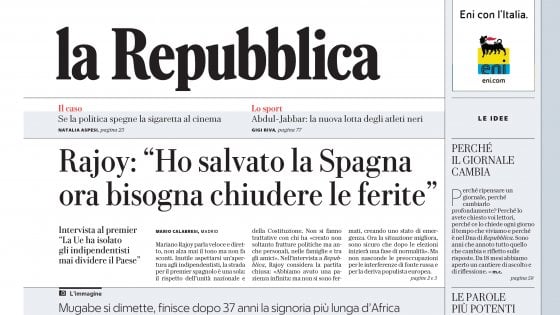
IL PITTORE SPARITO NEL MONTE VERITÀ
Di Chiara Gatti
Dieci anni di celebrità. Poi solo silenzio e studio disperatissimo. Così Luigi Pericle (1916-2001), autore basilese ma marchigiano d’origine, ha attraversato un pezzo di storia dell’arte del Novecento, apprezzato dai nomi più blasonati del sistema. Come il potente collezionista Peter G. Staechelin o sir Herbert Read, trustee della Tate Gallery, curatore del Victoria&Albert, nonché amico fidato di Peggy Guggenheim. La galleria Arthur Tooth&Sons, cenacolo alla moda nella Londra dei Fab Sixties, espose le opere di Pericle accanto a quelle di Picasso, Appel, Jorn, Tàpies, Dubuffet o Mathieu. E, ancora, all’apice del successo, il museologo Hans Hess, curatore della York Art Gallery, organizzò per lui una mostra itinerante in vari musei anglosassoni. Era il 1965. Ma, concluso il tour, Pericle svanì (scientemente) nel nulla. Via dalla pazza folla. Si ritirò, con la moglie Orsolina Klainguti, nel paradiso anarchico del Monte Verità, la famosa “collina dell’utopia” isolata fra i boschi del Canton Ticino sopra Ascona, affacciata sulla punta nord del Lago Maggiore. Fine del primo capitolo e inizio del secondo. Pochi mesi fa, una coppia di albergatori del posto, Greta e Andrea Biasca-Caroni, ha scoperto il tesoro di Pericle. La villetta di inizio secolo, inghiottita dai rovi dopo la scomparsa del maestro, sprigionava lo stesso magnetismo del Monte, quell’aria mistica, esoterica che attrasse letterati, poeti, artisti e teosofi di mezza Europa, da Kropotkin a Herman Hesse, da Isadora Duncan a Paul Klee; tutti approdati, col sogno di un ritorno a una vita vergine, in questo eden selvatico cui il critico Harald Szeemann ha dedicato fiumi di parole e mostre. Acquistata all’asta e riaperta dopo anni di decadimento, la casa ha svelato centinaia di dipinti e carte riposte in grosse scatole di legno stipate nei sotterranei. Le librerie custodivano ancora i volumi di letteratura, filosofia, arte egizia, teosofia, astrologia che nutrirono la conoscenza poliedrica di Pericle, fonte miracolosa di una ispirazione non limitata alla pittura ma riversata in migliaia di documenti autografi zeppi di oroscopi, scritti di ufologia, quaderni affollati di ideogrammi fonte miracolosa di una ispirazione non limitata alla pittura ma riversata in migliaia di documenti autografi zeppi di oroscopi, scritti di ufologia, quaderni affollati di ideogrammi giapponesi, simboli cosmici, medicina cinese e cure omeopatiche. La teoria del tutto, per Luigi Pericle, era la ricerca di una verità assoluta sulle cose di questo mondo e di un altro, al di là del visibile. “L’arte rispecchia la disposizione spirituale dell’uomo ed è uno strumento dotato di chiaroveggenza, essa ha sempre il presentimento degli accadimenti futuri”. Non stupisce che il suo immaginario fosse animato di figure ipnotiche, scenari visionari, mondi alieni, porte delle stelle, stargate aperti verso civiltà meccaniche. Una magnifica ossessione che lo allontanò dalla pittura-pittura per farne un pensatore libero, autore persino di un romanzo fantascientifico ambientato in un orizzonte post-atomico: il dattiloscritto inedito è riemerso insieme ai suoi quadri popolati di piramidi e golem, lune, arcangeli e misteriosi oracoli.
Il Tesoro nascosto
Due tele di Luigi Pericle ritrovate per caso : la villa vicino ad Ascona dove si era rifugiato l’artista 55 anni fa è stata acquistata da una coppia di albergatori che nei sotterranei ha trovato, in grandi casse di legno, centinaia di tele e disegni.
ENGLISH VERSION
THE PAINTER DISAPPEARED INTO THE MOUNTAIN OF TRUTH
By Chiara Gatti
Ten years of celebrity. Then just silence and desperate study. Thus Luigi Pericle (1916-2001), an author from Basel but originally from the Marche region, went through a piece of twentieth-century art history, appreciated by the most famous names in the system. Like the powerful collector Peter G. Staechelin or Sir Herbert Read, trustee of the Tate Gallery, curator of the Victoria&Albert and trusted friend of Peggy Guggenheim. The Arthur Tooth&Sons gallery, the fashionable art gallery in the London of the Fab Sixties, exhibited the works of Pericles alongside those of Picasso, Appel, Jorn, Tàpies, Dubuffet and Mathieu. And again, at the height of his success, the museologist Hans Hess, curator of the York Art Gallery, organised a travelling exhibition for him in various Anglo-Saxon museums. It was 1965. But after the tour, Pericles (knowingly) vanished into thin air. Out of the crazy crowd. Together with his wife Orsolina Klainguti, he retired to the anarchist paradise of Monte Verità, the famous “hill of utopia” isolated in the woods of the Canton Ticino above Ascona, overlooking the northern tip of Lake Maggiore. End of the first chapter and start of the second. A few months ago, a couple of local hoteliers, Greta and Andrea Biasca-Caroni, discovered the treasure of Pericle. The small villa of the beginning of the century, swallowed up by brambles after the death of the master, released the same magnetism of the Mount, that mystical, esoteric air that attracted writers, poets, artists and theosophists from half of Europe, from Kropotkin to Herman Hesse, from Isadora Duncan to Paul Klee; all arrived, with the dream of a return to a virgin life, in this wild eden to which the critic Harald Szeemann dedicated rivers of words and exhibitions. Bought at auction and reopened after years of decay, the house has unveiled hundreds of paintings and papers placed in large wooden boxes crammed into the basement. The bookshops still kept the volumes of literature, philosophy, Egyptian art, theosophy, astrology that nourished Pericles’ multifaceted knowledge, a miraculous source of inspiration not limited to painting but poured into thousands of autograph documents full of horoscopes, writings of ufology, notebooks crowded with ideograms, a miraculous source of inspiration not limited to painting but poured into thousands of autograph documents full of horoscopes, ufology writings, notebooks crowded with Japanese ideograms, cosmic symbols, Chinese medicine and homeopathic treatments. The theory of everything, for Luigi Pericle, was the search for an absolute truth about the things of this world and another, beyond the visible. “Art reflects the spiritual disposition of man and is an instrument endowed with clairvoyance, it always has the presentiment of future events. It is not surprising that his imagination was animated by hypnotic figures, visionary scenarios, alien worlds, doors of the stars, stargates open to mechanical civilizations. A magnificent obsession that distanced him from painting to make him a free thinker, even author of a science fiction novel set in a post-atomic horizon: the unpublished typescript has re-emerged along with his paintings populated by pyramids and golems, moons, archangels and mysterious oracles.
The Hidden Treasure
Two paintings by Luigi Pericle found by chance: the villa near Ascona where the artist had taken refuge 55 years ago was bought by a couple of hoteliers who found hundreds of paintings and drawings in large wooden crates in the basement.
READ THE ARTICLE OF THE CORRIERE DELLA SERA
***
Presentation For Curators click here
He was a visionary and expert in esoteric things: Luigi Pericle has left behind a huge job. The spectacular discovery in Ascona marks the beginning of a new chapter in the recent history of Swiss art.
The story of his life would be the subject of a novel. Also the rediscovery of his work. Luigi Pericle (Basel 1916 – Ascona 2001) is one of the forgotten names in Swiss art history – despite having already achieved international success in his lifetime. The discovery of a large number of works and documents marks the beginning of a process of reworking that sheds light on a fascinating work. At the first sight of the discovery in Ascona, where the artist lived from the early 1950s until his death, the diversity of his work, which escapes classification, was surprising. Pericle was a painter, illustrator, writer, theosophist, intellectual, mystic: a homo universalis. The Monte Verità, an auratic place that had attracted artists and other free spirits since the 1920s, constituted the humus for his artistic and spiritual research, which he pursued with an almost maniacal obsession.
Max – the marmot
Pericles’ career takes him through many stations. Already as a young man, his many interests are manifested. He attends an art school as a teenager, but then moves away and becomes self-taught. At first he was also interested in Zen philosophy, Egyptology and ancient Greece. This does not seem to be compatible with his activity as a cartoonist. In 1951 he created Max, the marmot who was the protagonist of the homonymous comic strip without text, which would become a character known not only in Europe, but also in the United States and Japan. With his work as an illustrator, Pericle achieved international fame. In 1958, at the age of forty-two, the artist destroyed all (except one) of his figurative works and began a new phase of his pictorial production. It was a transition to informal abstractionism and some techniques of pictorial elaboration. In 1959 his paintings received the interest of the famous Basel collector Peter G. Staechelin. This was the beginning of a passionate collaboration and a friendly attitude. Around 1959, the collector gave the artist a house in Ascona in exchange for the many works he had bought, where he lived until his death. Between 1958 and 1965 his works were exhibited in several exhibitions in England. After that there was a radical change. Pericle retired completely into his private life and devoted himself exclusively to his art and studies.The boundaries between disciplines are blurring. The huge number of ink drawings, for example, fascinates with a magical ambiguity in which sign, writing and image become one. Are these coded messages of his visions? However, the anchoring of these artworks to Pericles’ work in esoteric currents is insufficient. It is dangerous to put it in the drawer of Outsider-art. At the same time, the spiritual context must not be hidden. The 2013 Venice Biennale by Massimiliano Gioni, in particular, has shown how stimulating the dialogue between modern art and so-called esoteric art can be. Just remember names like Hilma af Klint or Emma Kunz. Luigi Pericle’s works would have been successful in this Biennale if his work had already been rediscovered then.Casa San Tomaso in Ascona was closed for fifteen years after the death of Luigi Pericle. The Luigi Pericle Archive, in collaboration with specialists, is now researching and developing the heritage of this extraordinary personality. Exhibitions are planned in Switzerland (for example at the Masi Museum in Lugano) and a first retrospective in Italy, which will be held in 2019 at the Area Scarpa of the Fondazione Querini Stampalia in Venice.
Marco Pasi at the Guggenheim NY, read the report
Marco Pasi on the “Corriere del Ticino”
**********************************************************************************
LA MISTERIOSA STORIA DI LUIGI PERICLE TORNA ALLA LUCE, DA ASCONA ALLA BIENNALE DI VENEZIA
pubblicato venerdì 1 marzo 2019
Eine künstlerische Entdeckung: Luigi Pericle
Mit dem Erwerb des ehemaligen Wohnhauses von Luigi Pericle Giovannetti (1916-2001) haben Andrea und Greta Biasca-Caroni, Direktoren des Hotels Ascona, einen Kunstschatz mit unbekannten Werken des Malers ans Licht gebracht. Der vielseitige Künstler erreichte den Höhepunkt seiner Karriere in den späten Fünfzigerjahren, als die Familie Staechelin, eine bedeutende Basler Familie, die sich einer Sammlung mit prestigeträchtigen Gemälden von Van Gogh, Picasso und Gauguin rühmt, für sein Werk interessierte und etwa hundert seiner Gemälde kaufte. Um ihn ungestört arbeiten zu lassen, schenkte ihm die Basler Familie ein Haus an den Hängen des Monte Verità in Ascona, wo Luigi Pericle einen Grossteil seines Lebens, zurückgezogen bis zu seinem Tod im Jahr 2001, verbrachte. Die gefundene Sammlung besteht aus zahlreichen Gemälden und Hunderten von Tuschzeichnungen in ausgezeichnetem Zustand, von denen einige u.a. im Hotel Ascona zu bewundern sind.
PRESS RELEASE – Luigi Pericle A (Rediscovered) Master of 20th Century Painting
4 languages press release : E/I/F/D
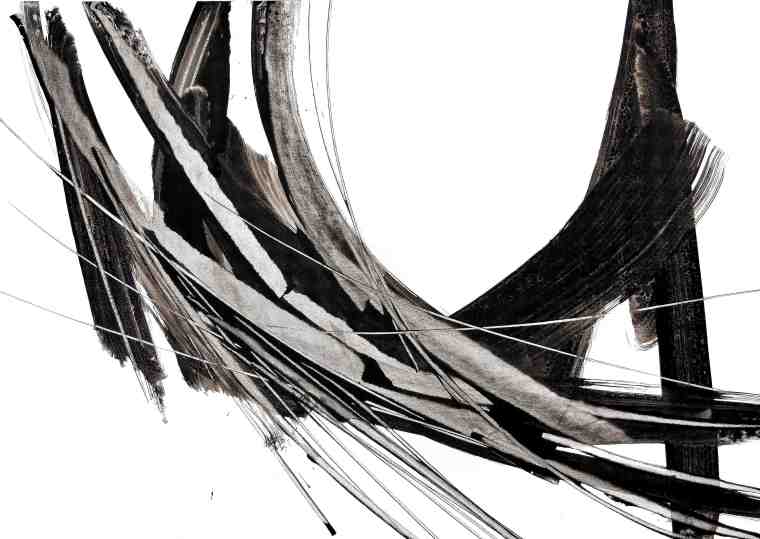
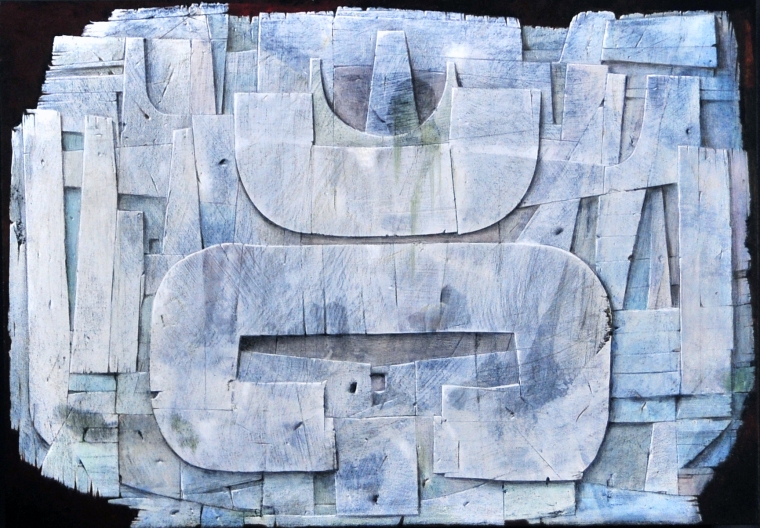
Luigi Pericle
A (Rediscovered) Master of 20th Century Painting
The work of a forgotten artist is brought back to life in Switzerland. Hundreds of paintings and drawings buried for decades are now returned to the history of modern art.
As a painter, an illustrator, and all around intellectual, Luigi Pericle (Basel, 1916- Ascona, 2001) was influenced by theosophy and esoteric doctrines, and actively took part in the artistic and cultural debate engendered over the past century by these trends.
Luigi Pericle spent his life on the slopes of Monte Verità (literally “Mountain of Truth”), in the Swiss Canton of Ticino, which, in the early 19th century, welcomed the community founded by Ida Hofmann and Heinrich Oedenkoven on the Hill of Utopia, a cliff looking over Lake Maggiore that attracted exponents from the European ‘counter-culture’ of the time. Beginning in the 1930’s, these same places saw the beginning of the extraordinary intellectual adventure of the Eranos meetings, promoted by Carl Gustav Jung (whose The Red Book was rediscovered in recent years and exhibited at the Venice Biennale in 2013) and by Dutch theosophist and painter Olga Froebe-Kapteyn.
It is the cultural climate of Monte Verità that Luigi Pericle dreamt of being a part of when, in the early 1950’s, he decided to move with his wife to Ascona. The artist chose that place to absorb the mystical aura of Monte Verità and plunge into its nature and peace.
Pericle was a multifaceted artist with manifold interests; he escaped any classification and confirmed to be a professional painter as well as a talented cartoonist. In 1951, he created the marmot Max, protagonist of his comic strips with no texts, which soon became a famous character in Europe and farther afield, in the US and Japan. With his work as an illustrator, Pericle gained international fame, and his comics were released by New York publisher Macmillan in popular newspapers such as The Washington Post, The Herald Tribune, or the magazine Punch.
(please read more)
DOWLOAD THE PRESS RELEASE HERE CS_Pericle_EN
Luigi Pericle Archives, Ascona, Switzerland
Andrea & Greta Biasca-Caroni
tel +41 (0)79 621 23 43 – +41 (0)79 245 09 65
c/o Hotel Ascona – Via Signore in Croce, 1 – CH – 6612 Ascona
www.luigipericle.com – info@luigipericle.com
___________________________________________________________________________________________________________________________________________________________
Luigi Pericle
Un maestro (ritrovato) della pittura del Novecento
Riemerge, in Svizzera, l’opera di un artista dimenticato. Centinaia di dipinti e disegni rimasti sepolti per decenni, restituiti oggi alla storia dell’arte moderna.
Pittore, illustratore, letterato e intellettuale a tutto tondo, Luigi Pericle (Basilea 1916-Ascona 2001) subì l’influenza della teosofia e delle dottrine esoteriche, partecipando profondamente al dibattito artistico e culturale che da queste tendenze fu determinato nel corso del secolo.
Luigi Pericle, trascorse la sua vita alle pendici del Monte Verità che, in terra ticinese, accolse fin dagli albori del Novecento la famosa comunità fondata nel 1900 da Ida Hofmann e Heinrich Oedenkoven sulla Collina dell’Utopia, a picco sul Lago Maggiore, dove approdò tutta la “controcultura” europea del tempo. È in quegli stessi luoghi che, a partire dagli anni Trenta prese forma la straordinaria avventura intellettuale degli incontri di Eranos, promossi da Carl Gustav Jung (il cui Libro Rosso è stato riscoperto in anni recenti ed esposto alla Biennale di Venezia del 2013) e dalla teosofa e pittrice olandese Olga Froebe-Kapteyn.
È il clima culturale di Monte Verità che Luigi Pericle sognò di frequentare quando, nei primi anni Cinquanta, decise di trasferirsi con la moglie ad Ascona, l’artista scelse tale luogo per assorbire l’aura mistica del Monte Verità e immergersi nella sua natura e nella pace.
Uomo poliedrico e dai mille interessi, Pericle sfugge alle classificazioni e si rivela artista professionista tanto quanto fumettista di talento: nel 1951, infatti, crea Max, la marmotta protagonista dell’omonimo fumetto senza testo, destinata a divenire volto noto non solo in Europa, ma anche negli Stati Uniti e in Giappone. Con il suo lavoro di illustratore, Pericle acquista fama internazionale e i suoi lavori vengono pubblicati dall’editore Macmillan di New York e su quotidiani e periodici come il “Washington Post”, “Herald Tribune” o la rivista “Punch”.
continua a leggere, SCARICA IL COMUNICATO STAMPA CS_Pericle_iTA
Luigi Pericle Archives, Ascona, Switzerland
Andrea & Greta Biasca-Caroni
tel +41 (0)79 621 23 43 – +41 (0)79 245 09 65
c/o Hotel Ascona – Via Signore in Croce, 1 – CH – 6612 Ascona
www.luigipericle.com – info@luigipericle.com
_______________________________________________________________________________________________________________________________________________________________
Luigi Pericle
Un maître (retrouvé) de la peinture du vingtième siècle
En Suisse, l’œuvre d’un artiste oublié est en train de refaire surface. Des centaines de peintures et de dessins dont on avait perdu la trace pendant des dizaines d’années, sont aujourd’hui restituées à l’histoire de l’art moderne.
Peintre, illustrateur, homme littéraire et intellectuel à part entière, Luigi Pericle (Bâle 1916 – Ascona 2001) a subi l’influence de la théosophie et des doctrines ésotériques en participant profondément au débat artistique et culturel de ces tendances qui ont caractérisé le cours du siècle.
Luigi Pericle a passé sa vie sur les versants du Monte Verità qui, en terre tessinoise, a accueilli dès le début du vingtième siècle la fameuse communauté fondée en 1900 par Ida Hofmann et Heinrich Oedenkoven sur les collines de l’Utopie, à pic sur le Lac Majeur, là où s’installa toute la « contre-culture » européenne de l’époque. C’est dans ces lieux, qu’à partir des années Trente, a pris forme l’extraordinaire aventure intellectuelle du Cercle d’Eranos, soutenue par Carl Gustav Jung (dont le Livre Rouge a été redécouvert ces dernières années et a été exposé à la Biennale de Venise en 2013) et par la théosophe et peintre hollandaise Olga Froebe-Kapteyn.
C’est le climat culturel du Monte Verità que Luigi Pericle rêvait de fréquenter, lorsqu’au début des années cinquante, il décida de s’installer avec sa femme à Ascona. L’artiste avait choisi ce lieu pour absorber l’aura mystique du Monte Verità et s’immerger dans sa nature et sa paix.
Homme polyvalent et aux mille intérêts, Pericle ne fait partie d’aucune classification et se révèle aussi bien artiste professionnel que caricaturiste de talent : en effet, en 1951 il créa Max, la marmotte héros de la bande dessinée éponyme, sans texte, destinée à devenir un personnage familier non seulement en Europe, mais également aux États-Unis et au Japon. Avec son travail de caricaturiste, Pericle acquit une renommée internationale et ses travaux furent publiés par la maison d’édition Macmillan de New York, et sur les quotidiens et journaux périodiques comme le Washington Post, Herald Tribune ou la revue Punch.
(en savoir plus)
COMMUNIQUÉ CI-JOINT, TELECHARGER ICI CS_Pericle _fra
Archives Luigi Pericle, Ascona, Suisse
Andrea & Greta Biasca-Caroni
tél. +41 (0)79 621 23 43 – +41 (0)79 245 09 65
c/o Hôtel Ascona – Via Signore in Croce, 1 – CH – 6612 Ascona
www.luigipericle.com – info@luigipericle.com
_____________________________________________________________________________________________________________________________________________________________
Luigi Pericle
Ein (wiederentdeckter) Meister der Malerei des 20. Jahrhunderts
In der Schweiz ist das Werk eines vergessenen Künstlers wieder aufgetaucht – Hunderte von Bildern und Zeichnungen, die Jahrzehnte lang begraben lagen, werden nun der Geschichte der modernen Kunst zurückgegeben.
Der Maler, Illustrator, Literat und Intellektuelle Luigi Pericle (Basel 1916-Ascona 2001) erlebte den Einfluss von Theosophie und esoterischen Lehren und beteiligte sich rege an der künstlerischen und kulturellen Debatte, die im Laufe des Jahrhunderts durch diese Trends geprägt war.
Er verbrachte sein Leben an den Hängen des Monte Verità, der im Tessin seit Anfang des 20. Jahrhunderts Treffpunkt der berühmten, von Ida Hofmann und Heinrich Oedenkoven im Jahre 1900 gegründeten Gemeinde auf dem utopischen Hügel über dem Lago Maggiore war, wo die gesamte europäische „Gegenkultur“ jener Zeit zusammen kam. An diesen Orten nahm ab den dreißiger Jahren das außergewöhnliche intellektuelle Abenteuer der Eranos-Tagungen Gestalt an, das von Carl Gustav Jung (dessen Rotes Buch in den letzten Jahren wiederentdeckt und auf der Biennale in Venedig 2013 ausgestellt wurde) und von der holländischen Theosophin und Malerin Olga Froebe-Kapteyn gefördert wurde .
Eben dieses kulturelle Klima des Monte Verità war es, von dem Luigi Pericle geträumt hatte, als er Anfang der fünfziger Jahre beschloss, mit seiner Frau nach Ascona zu ziehen. Der Künstler wählte diesen Ort, um die mystische Aura des Monte Verità in sich aufzunehmen und in seine Natur und seinen Frieden einzutauchen.
Als facettenreicher Mann mit tausend Interessen entgeht Pericle herkömmlichen Klassifizierungen und erweist sich als professioneller Künstler ebenso wie als talentierter Karikaturist: 1951 kreiert er Max, den Murmeltier-Protagonisten des gleichnamigen Comics ohne Text, der nicht nur in Europa, sondern auch in den USA und in Japan eine bekannte Figur werden sollte. Mit seiner Arbeit als Illustrator erlangt Pericle internationale Bekanntheit, und seine Werke werden vom Verleger Macmillan in New York sowie in Zeitungen und Zeitschriften wie der „Washington Post“, der „Herald Tribune“ oder „Punch“ veröffentlicht.
(mehr lesen)
BEIGEFÜGTES KOMMUNIQUÉ PRESSEMITTEILUNG
THE LUIGI PERICLE ARCHIVE, Ascona, Svizzera
Andrea & Greta Biasca-Caroni tel +41 (0)79 621 23 43
c/o Hotel Ascona – Via Signore in Croce, 1 – CH – 6612 Ascona
www.luigipericle.com – info@luigipericle.com

